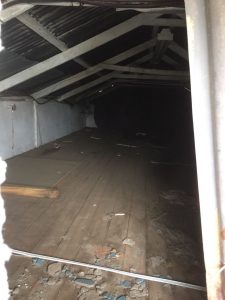From the Anglican Church we take a right turn into Pretorius street. It was likely named after one of the well known “Driemanskap” the former president of Transvaal, MW Pretorius. The Waverley Hotel stood on the corner which was used as a hospital (1899 – 30/09/1900) during the Anglo Boer War.
Dr James O’Reily lived next to the hotel. His wife, Cassie assisted as a nurse. His dwelling is now part of the O’Reilly business complex, Although his tennis court no longer exists, his old pigeon loft on top of the roof can still be seen.
During the British occupation of Heidelberg in June 1900, the officer in command, Captain Vallentin, requested him to stay on as district surgeon. He had already occupied the post 11 years prior to the war. Dr O’Reilly denied to stay on, as he was loyal to his oath in service of the Boer Republic. He did not want to serve under the British amidst the war. The British recorded his sympathy towards the Boers and suspected him supplying them with information. The information would include the location of British forts as well as the time roster of trains through Heidelberg.
Using this information the Boers knew when to sabotage the railway lines. General Cooper and Major English played tennis with him to keep an eye of his whereabouts. They suspected that maps of the forts were hidden in mealie sacks which he transported to his pharmacist friend, Walter Harvey on his farm. The Boers in the veld would then later fetch it there, commonly known as the Boers Post Office.
A breakthrough occurred when they investigated that the doctor transported pigeons on house visits. This innovative plan helped his patients to communicate their well being to him. It was a very good use of carrier pigeons in Heidelberg. The British thought nothing of it and deported him to the Cape. After his wife, Cassie, complained they relocated him to a concentration camp at Merebank.
Dr. O’Reilly made a big impression in Heidelberg. He was the co-founder of the Heidelberg Club and Volkskool. He also sat on the Executive Committee for many years. On the photo he can be seen in the front row, on the left of Mahatmar Ghandi (holding a bouquet) wearing a long jacket. This was taken during Ghandi’s official visit to Heidelberg Station in 1910. To the right behind him is his life-long friend and pharmacist Walter Harvey – also publicly active in Heidelberg. Harvey served as mayor and laid the corner stone of the Land Bank building. After receiving advice from the RedCross, in Pretoria, Dr. O’Reilly and his wife served on the ambulance train to Elandslaagte. The two bosom friends died in the same year in 1938. Harvey (77) and Dr O’Reilly (82), together with their wives, were buried in the Kloof Cemetry. On the left behind Dr. O’Reilly is mr Moti, from Moti and Sons, a business that is still active in Shalimar Ridge.
Dr. O’Reilly was not the only mysterious medical doctor and co-founded of Heidelberg Club. Dr. Edward John Nixon from Manchestor, a loyal friend and colleague, also practiced in Heidelberg. He actively served as Master of the Free Masons’ Lodge 2354, since 15 September 1890. The Lodge was situated in Fenter Street. The building has been converted into separate housing units. It is interesting to note that the Royal Freemasons Retirement home is situated in the town Heidelberg in Vicotria State, Australia.
It is common knowledge that the peace negotiations at the end of the war took part in Mclaren’s home in Heidelberg. Peace negotiations are synonymous white doves. Dr. O’Reilly’s pigeon loft on top of his house is still proof that many mysteries and events from the past can be found in Heidelberg.
